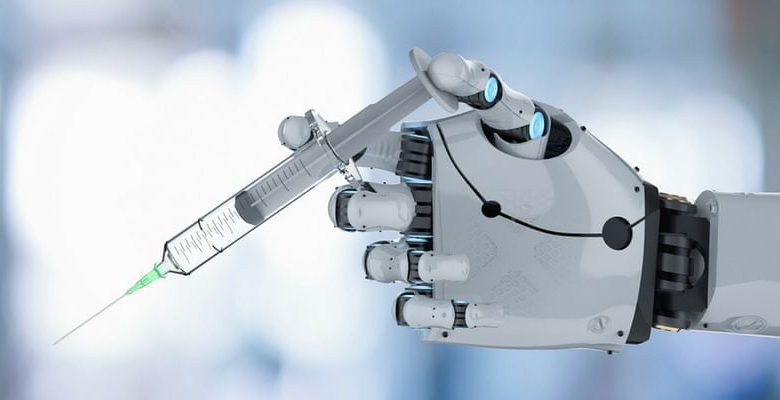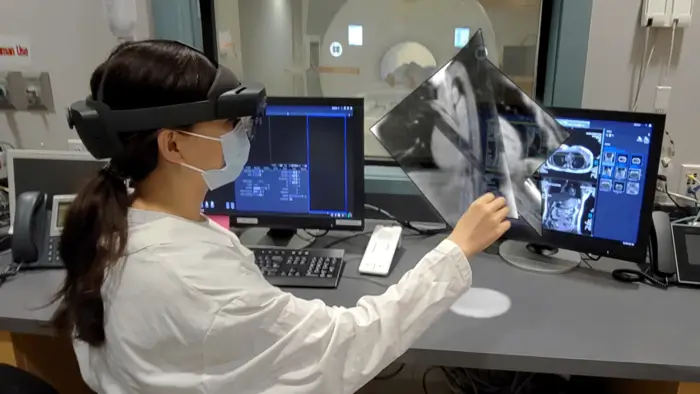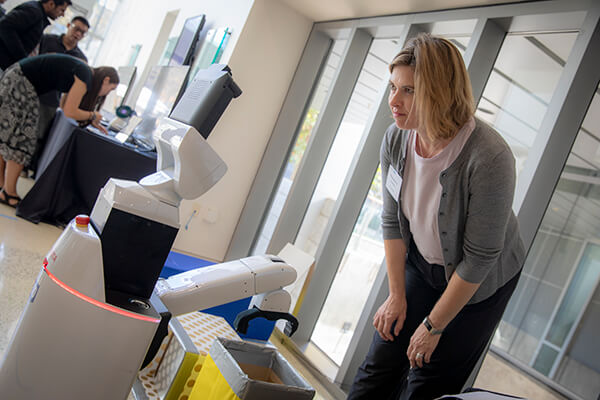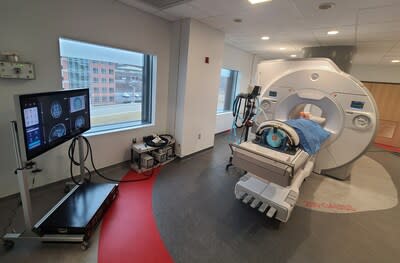
In a world where technology is advancing at an incredible pace, one of the most exciting innovations is the benefits of AI in Medicine and Healthcare.
You might have heard of AI as the brain behind self-driving cars or virtual assistants like Siri.
But did you know that AI is also making a huge impact in the field of medicine?
Imagine a future of AI in Medicine, where computers work side by side with doctors, helping them diagnose diseases faster and more accurately than ever before.
This is the powerful synergy between AI and medicine, and it’s revolutionizing the way we approach healthcare.
The Marvelous Merger: AI in Medicine

Picture this: Doctors equipped with a digital detective that can analyze medical data, spot issues that might be invisible to the human eye, and assist in making the right decisions.
This is the world of AI in medicine, where technology collaborates with medical expertise to provide unparalleled benefits.
AI, in simple terms, is like a smart helper that learns from data and experiences, just like you do.
But it can process massive amounts of information in the blink of an eye, something humans could never achieve alone.
Economic Impact of AI in Healthcare (Revolutionizing Medicine)
Benefits of AI in Medicine and Healthcare
AI’s Role in Diagnosing Diseases
The way AI in Medicine can revolutionize the Medical Industry is beyond imagination and the benefits of AI in Medicine are beyond measurement.
With just a concise and trained AI model a doctor’s efficiency could improve hundreds of folds.

AI’s Detective Skills on Medical Data
Consider some detectives solving complex mysteries.
They scrutinize every detail, connect the dots, and uncover the truth.
Similarly, the Future of AI in Medicine can analyze medical data—such as X-rays, scans, and test results—to identify diseases accurately.
Imagine you have an X-ray of your chest taken. AI can swiftly examine it, spotting even the tiniest anomalies that might signal a problem.
Real-Life Examples of AI in Medicine
Remember, AI in Medicine is not just some futuristic concept; it’s already at work in hospitals and clinics.
In fact, AI has shown incredible prowess in detecting eye diseases.
For instance, diabetic retinopathy—a condition that damages the retina—can lead to blindness if not caught early.
AI algorithms have demonstrated their ability to identify signs of diabetic retinopathy in images, potentially saving people’s vision by alerting doctors to the condition.
But it’s not just about eyes.
AI can spot patterns that humans might miss, like tumors in medical scans or irregularities in heart rhythms.
The superhuman benefits of AI in Medicine to recognize even the subtlest changes in data is transforming the accuracy and speed of disease diagnosis.
Shocking Disadvantages of Artificial Intelligence in Education
Personalized Treatment Plans
Everyone in the world wants personalized treatment and it is never possible with manpower.
It means to have the same number of Doctors as the number of patients that makes its impossible to deal with.
But with the help of AI in Medicine, it has been made possible due to its immeasurable ability to manage data.

Crafting Personalized Healthcare with AI
Imagine going to a restaurant and ordering a dish made just the way you like it.
Well, AI is like a master chef when it comes to healthcare—it creates treatment plans that are customized for each individual’s needs.
Just like a recipe that combines different ingredients to make a delicious meal, AI in Medicine combines a person’s medical history, genetic information, and current health status to create the perfect treatment “recipe.”
Wearable Wonders: Your Health in Real-Time
Have you seen those cool gadgets people wear on their wrists that track their steps and heart rate?
These wearable devices are like health trackers, and they play a big role in the partnership between AI and medicine.
AI uses the data collected from these devices to monitor your health in real-time.
If your heart rate spikes or your blood sugar levels go haywire, AI sends an alert to your doctor.
This means treatments can be adjusted quickly, preventing potential problems from getting worse.
Discover the Future of AI in Radiology (Key Benefits)
Virtual Health Assistants

Your Friendly Health Guru: AI-Powered Chatbots
Think of AI-powered chatbots as your knowledgeable friend who’s always there to answer your health questions.
These digital assistants are designed to provide medical advice and information based on your symptoms and concerns.
Just like a good friend listens and gives advice, AI chatbots in Medicine listen to your descriptions of symptoms and provide guidance on what might be going on with your health.
Meet Ada and Buoy: Your Health Companions
Imagine waking up with a sore throat and feeling unsure whether it’s just a cold or something more serious.
This is where AI-powered health companions like “Ada” and “Buoy” come to the rescue.
These friendly tools ask you questions about your symptoms and then use their AI smarts to suggest possible conditions and whether you should consider seeing a doctor.
This is the Future of AI in Medicine!
It’s like having a pocket-sized healthcare expert who helps you make informed decisions about your health.
Every Businessman Wants These Benefits of AI in Business
Faster Drug Discovery

Unlocking New Medicines with AI
Imagine having a super-fast microscope that can zoom in on the tiniest details of diseases.
Well, that’s what AI is like for scientists searching for new medicines.
It’s like having a super-powered detective that can find the keys to unlock diseases.
AI analyzes massive amounts of data to identify patterns and connections that humans might miss.
This means scientists can find potential treatments faster and with more accuracy.
Repurposing Medicines: AI’s Hidden Talent
AI doesn’t just help find new medicines from scratch; it’s also great at finding new uses for existing drugs.
Imagine you have a puzzle piece that fits in one spot, but AI sees that it could fit in many others too.
In the same way, AI in Medicine can recognize that a drug designed for one purpose might be useful for treating a different illness.
This saves time and resources, bringing potential treatments to patients sooner.
How to Become a Prompt Engineer (ChatGPT Prompt Engineering)
Ethical Considerations and Future of AI in Medicine

AI’s Responsibility: Protecting Patients and Data
While AI holds incredible promise, it’s important to use it responsibly because the future of AI in Medicine can prove very dangerous if not given proper supervision.
Just like doctors take an oath to do no harm, AI should be used in ways that prioritize patient safety and privacy.
Protecting patient data is crucial.
Think of it like a secret recipe—only authorized people should have access to it.
Navigating Challenges: AI Errors and Human Oversight
Even superheroes have their off days, and AI is no different.
Sometimes, AI might make mistakes or misinterpret data.
That’s why human oversight is crucial.
It’s like having a co-pilot when flying a plane—AI helps, but humans make sure everything’s on track.
Doctors and scientists work alongside AI to ensure decisions are sound and safe.
Partnership for Success: Doctors and AI
Imagine astronauts in space working with mission control on Earth.
Doctors and AI have a similar partnership. AI brings advanced analysis skills, while doctors get their knowledge and experience.
Together, they make a formidable team.
AI doesn’t replace doctors; it enhances their capabilities, making healthcare better and more precise.
Conclusion
As we journey through the exciting world of AI in medicine, we discover its role in speeding up drug discovery and its potential for repurposing existing treatments.
Yet, it’s vital to remember that with great power comes great responsibility.
Ethical considerations, patient privacy, and human oversight are key aspects to ensure AI benefits us without harm.
Just as astronauts rely on mission control, doctors and AI work hand in hand to achieve remarkable results in healthcare.
So, embrace this dynamic partnership, where AI’s speed and precision merge with human expertise, shaping a future where medicine becomes even more advanced, accessible, and safe.
Imagine a world where quality healthcare reaches everyone, regardless of their location.
Thanks to the benefits of AI in Medicine, this vision is becoming a reality.
AI is breaking down geographical barriers, and connecting patients with medical expertise globally.
And here’s the exciting part—you have a role in this transformation!
Your curiosity and creativity can contribute to the future of AI in medicine.
Whether you’re drawn to diagnosing diseases like a digital detective or crafting personalized treatments, the possibilities are endless.
Embrace your curiosity, explore, and know that you could be the one shaping a future where AI and medicine work hand in hand to create better, more accessible healthcare for all.



